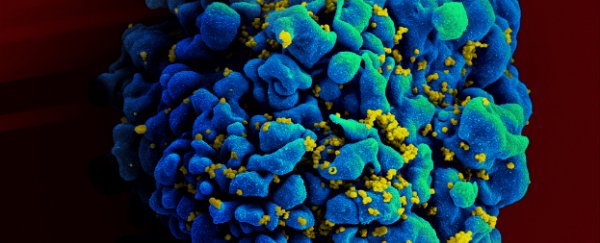French researchers have pinpointed a genetic mutation that has resulted in two men showing no symptoms or clinical traces of HIV, despite being infected by the virus for at least three years.
They've found that, in both patients, the HIV virus was shut down as a result of its genetic code being altered - something they believe was triggered by the activation of a group of enzymes known as APOBEC enzymes.
The research suggests that by activating these enzymes in other patients, we may be able to disable the AIDS-causing virus even after someone's already been infected. In fact, it's one of the first potential "cures" put forward that would result in a patient remaining infected by HIV.
The scientists were so fascinated by the two patients because neither had developed any symptoms, despite being infected with HIV for years. One of the men had been diagnosed as HIV positive 30 years ago, and the other was diagnosed in 2011. But despite that, the virus was present in such low levels that it could not be detected in routine blood tests, and it also wasn't causing them any symptoms or ill health.
The researchers from France's Institute of Health and Medical Research believe that these two patients are not unique, and their lack of symptoms are a result of an evolutionary shift between some humans and the virus - a spontaneous phenomenon known as endogenisation.
Their results are published in the current issue of Clinical Microbiology and Infection.
In the paper they explain that it's well known that around 1 percent of people infected with HIV are naturally able to keep the virus at clinically undetectable level. However, no one quite knew what this genetic mechanism was until now.
To work out what was going on, the researchers used deep sequencing to track down the small amounts of HIV DNA that were present in the patients' cells (when a HIV virus infects a human cell, it translates its viral RNA into DNA and inserts itself into our genome).
They then studied the chunk of viral genetic code, as well as the infected human genome, to work out what was making HIV harmless in both of the men and stopping it from replicating itself.
What they found was that the genetic code that usually stops the human cell from expressing the APOBEC enzymes had been altered.
This alteration had resulted in the APOBEC enzymes being expressed and going on to cause further mutations in the HIV's genome - changes that effectively stopped it from replicating and spreading throughout the body.
"This finding represents an avenue for a cure," biologist Didier Raoult, co-author of the study, told AFP.
Fascinatingly, this cure would be completely different to anything tried before because, instead of trying to eradicate HIV from the body, it suggests that someone needs to actually remain infected by the virus to be cured.
"The work opens up therapeutic avenues for a cure, using or stimulating this enzyme, and avenues for identifying individuals among newly infected patients who have a chance of a spontaneous cure," the authors told International Business Times.
"We suggest that persistence of integrated HIV DNA is not a barrier, but on the contrary, may be a prerequisite to HIV cure."
It's important to note, however, that the research is still in its very early stages, and having only studied two patients with this genetic mutation so far, it's very difficult to tell how successful the process will be on a larger scale. Also, in the past we've learnt that, unfortunately, just because a patient doesn't show symptoms for a few years, doesn't mean they never will.
Still, it's an interesting avenue of research and it opens up the possibility that perhaps HIV and humans could eventually learn to coexist.
We'll be eagerly watching what happens next.
